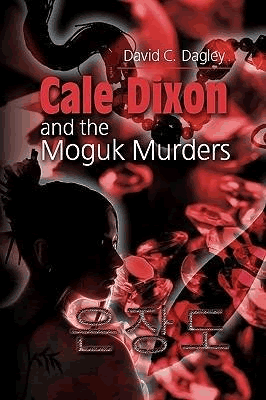 Title: Cale Dixon and the Moguk Murders
Title: Cale Dixon and the Moguk MurdersSeries: Cale Dixon
Published by: Strategic Book Publishing & Rights Agency, LLC
Release Date: 13 April 2010
Pages: 336
ISBN13: 978-1609119560
Cale Dixon, a detective on suspension, is assigned a research case just prior to reinstatement. A South Korean man, the oldest son of the Won family, is found with a mouthful of Moguk rubies and stabbed in the back with an Un Jang do knife that has been discretely passed down though generations of the Cho dynasty women. Cale has nothing to go on so he travels on a scheduled vacation but alters course to Burma to learn about the Moguk Ruby. He, by chance, falls in the right hands and meets up with a major Mandalay jewelry family. While the jewelers do some black market research for Cale, he tours the Burmese countryside somewhere between hiding from the secret police and running from them. After traveling through the repressed land, he returns to the states and gets more turns and twists than he bargains for.
Publisher's website: http://sbprabooks.com/davidcdagley/
EXCERPT FROM THE BOOK
When we were little boys we went to school together, north of here in the Moguk region. Our fathers’ were jewelers and miners, as were their fathers. My grandfather was here when the British over ran and ruled our country. Our family was hired by the British because of my grandfather’s skill and knowledge. He used to tell us stories about the funny ways of the foreigners. Many stories had to do with greed and the want of our natural resources. In the surrounding hills and mountains there are Teak, Evergreen, and Tropical Evergreen trees. On the eastern mountainside of the Shan plateau, opium is grown and has been growing there for a long time. In the Irrawaddy valley, we can grow cotton, ground nuts, jute, rubber trees, coconut, tobacco, tea, citrus fruits, sugarcane, wheat and dry rice. We used to grow wet rice in exportable amounts much greater than today. Below the surface of our country we can mine for; lead, zinc, tin, iron, nickel, copper, coal, oil, natural gas, and, my favorite, precious and semi-precious stones. We have Tigers eyes, zircons, sapphires, spinrels, tourmalines, and rubies, - among others. From generation to generation we have been working the stones. When the British came we mined for them. The British came in three waves taking our lands and changing our way of life. My grandfather was a very smart man and learned English very quickly. But he did not let the officers and the businessmen know how much English. He also understood their greed for he shared in their desire for the stones. While working and cutting stones for the British, he would take a few rough stones everyday. For twenty years he took stones from the British businessmen. And what would you expect, he was a jeweler. With his humble treasure, he insured our futures, at least as far as he could see. My father learned from my grandfather and became one of the finest freehand stone cutters in Burma. The queen of England has some of his works and the King of Thailand and many other royal families around the world. These are the stones with pigeon blood color. To our family, it is not pigeon blood. It is our blood and our country’s blood and sweat that help make the stones come to life. My father went to the University of Rangoon for a short time. He met with Thakin Aung San, a hero of his time. He also met Thakin Nu, who later became our Prime minister. Many of the Thakin party leaders were in university at that time, some older, all with eyes wide open. My father wanted to join with them and fight for our country’s independence. My grandfather wouldn’t have it. For fear of his son’s life, my grandfather took him out of university and brought him home, back to the jewelry shop where he remained and started a family. This is my younger brother and these two are my adopted cousins. Their father died of malaria and my father and mother brought them and their mother into our house to stay forever. All four of us went to University as well. But the political situation had gotten worse after our independence in nineteen forty-eight. Some insurgent groups in the hills didn’t want to live under the same constitution or religion. Some wanted their own independent state. Fighting was everywhere. In July, nineteen forty-seven, General Aung San and seven of his ministers were killed by U Saw and his gunmen. Many believe Thakin Shu Maung was the master mind. You may know him as, Ne Win. He ran the military and our Prime minister, U Nu, from puppet strings when he was alive, very powerful. The fight against what he put in political motion goes on today through Aung San’s daughter, Aung San Suu Kyi. Our father did as his father did and brought us home.
REVIEWS
“Cale Dixon and the Moguk Murders is a stunning work that plums the depths of international criminality, historical conspiracy, and the inner psyche of the noir landscape. Crisscrossing oceans and cultures, author David C. Dagley establishes a shadowy world of scope and complexity, bringing the reader along into lands peopled by the secretive, the dangerous, and the violent – whether it be San Francisco, or the Burmese countryside. The hero of this novel is Cale Dixon, a hardboiled detective in the classic Hammett style … Mr. Dagley executes the detective-novel tone perfectly, bringing traces of Chandler and even Doyle to the work, while as well maintaining the breadth of an international thriller – thus playing out the murders and intrigues on a global scale … I thoroughly enjoyed this book, and I would recommend it to any fan of the genre.”
Charles Asher
"First of all, let me state that I'm borrowing my wife's Amazon log in. Patty consumes books. I, Howard, on the other hand, am proud to say I read one, maybe two books a year. Therefore, I must choose my books carefully. Typically I go for travel/adventure non-fiction, but if reading fiction I always lean toward the mystery genre. In Dagley's first book, I got both!
I won't reveal any of the plot, but Dagley has written a great story. As Dixon travels abroad in search of clues to his murder investigation, he spends a good deal of time in Burma. Any good writer must research their subject matter thoroughly, and Dagley shares insightful views into Burmese history and its political and ethnic struggles. That's the non-fiction part woven in, with apt creative license. The story starts in San Francisco and new characters are introduced in Idaho, South Korea, and of course, Burma. It's a page turner that builds and builds suspense. Finally, on the very last page after Cale pieces together most of the puzzle, it is clear that there will be more.
As I write this I am still smiling from the fulfillment of reading Cale Dixon And The Moguk Murder, and anxious to read the continuing story that is sure to come. ~ Howard"
Patricia & Howard Flax
I believe I read somewhere that this is a debut novel. If so, this was much, much better than most debut novels. Enough so that I could be mistaken and offer my apologies if I am wrong.
At any rate, the story is well thought out and reads far more quickly than many books of the same length. Plus, I feel as if I've traveled through Southeast Asia with a bloke that knows the region.
I had no clue as who the Moguks or the Cho's are, so the writer grabbed my attention from the start. Well, at least starting with the scene of the crime.
If I were to offer some advice, well, it would be to suggest the writer try to show instead of tell us what is visible. What I mean is, shift his point of view to first person or third person. A scene with first person thinking to himself as to what he sees, some of the time, and at other times to his discussion with someone, or what he overhears, or THINKS a he overhears, is a potent means to introduce what is seen or heard. Further, it can include what the first person mistakenly sees or overhears, which allows a better means to mislead readers to an incorrect, or a suspicion, that can turn out to be wrong.
Third person includes some of the same twists and turns.
The best point is, though, that the method allows facts, or nuggets of information, to be introduced in a way that readers can feel, smell, touch or hear themselves. Imagine you overhear one person say to another, "Wow. The boss is going to be upset when he learns that all those rubies were used to choke that guy until he vomited them up."
"Yeah. The Cho is going to be disgusted to find out some Moguk contaminated his priceless jewels."
That is a shoot-from-the-hip attempt to demonstrate the concept. Having so stated, don't get me wrong. This is an especially well written story as it is written. I am just sayin'.
I look forward to watching this guy grow and, someday, to signing a deal with a cable network for a TV series much like Craig Johnson did with awalt Longmire.
Bill Anderson

